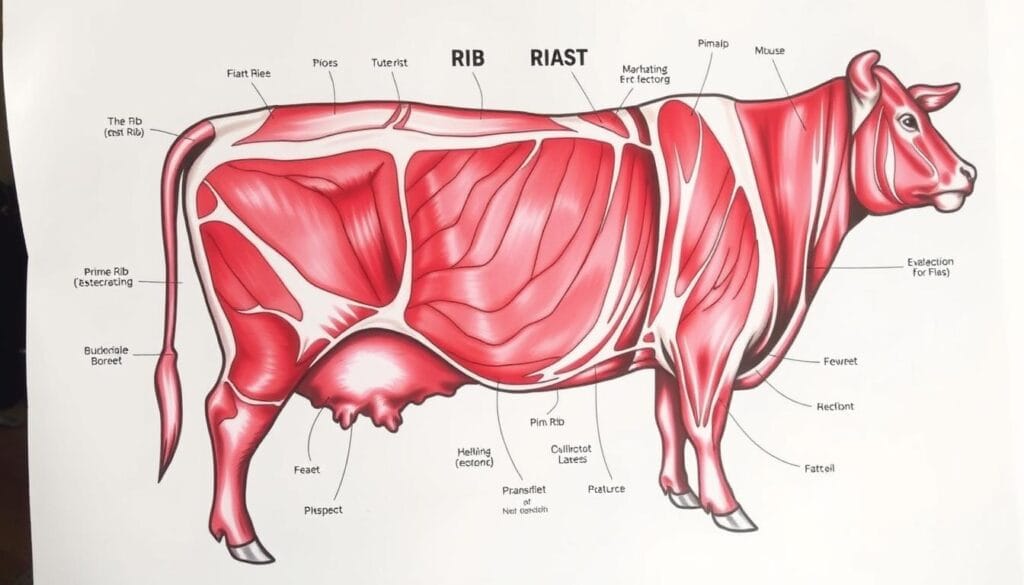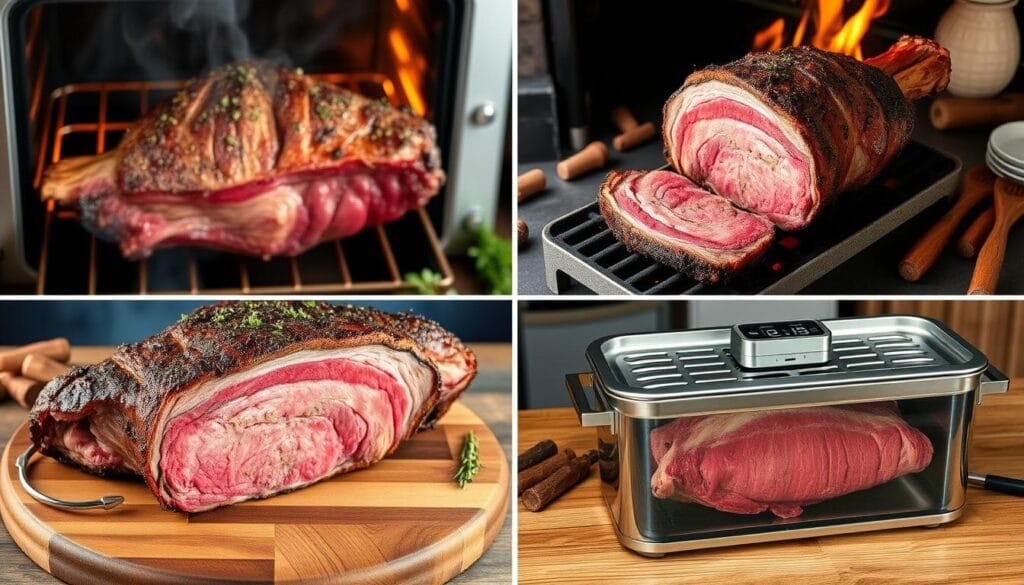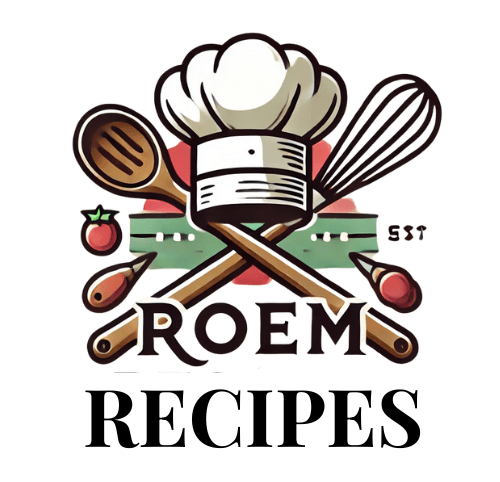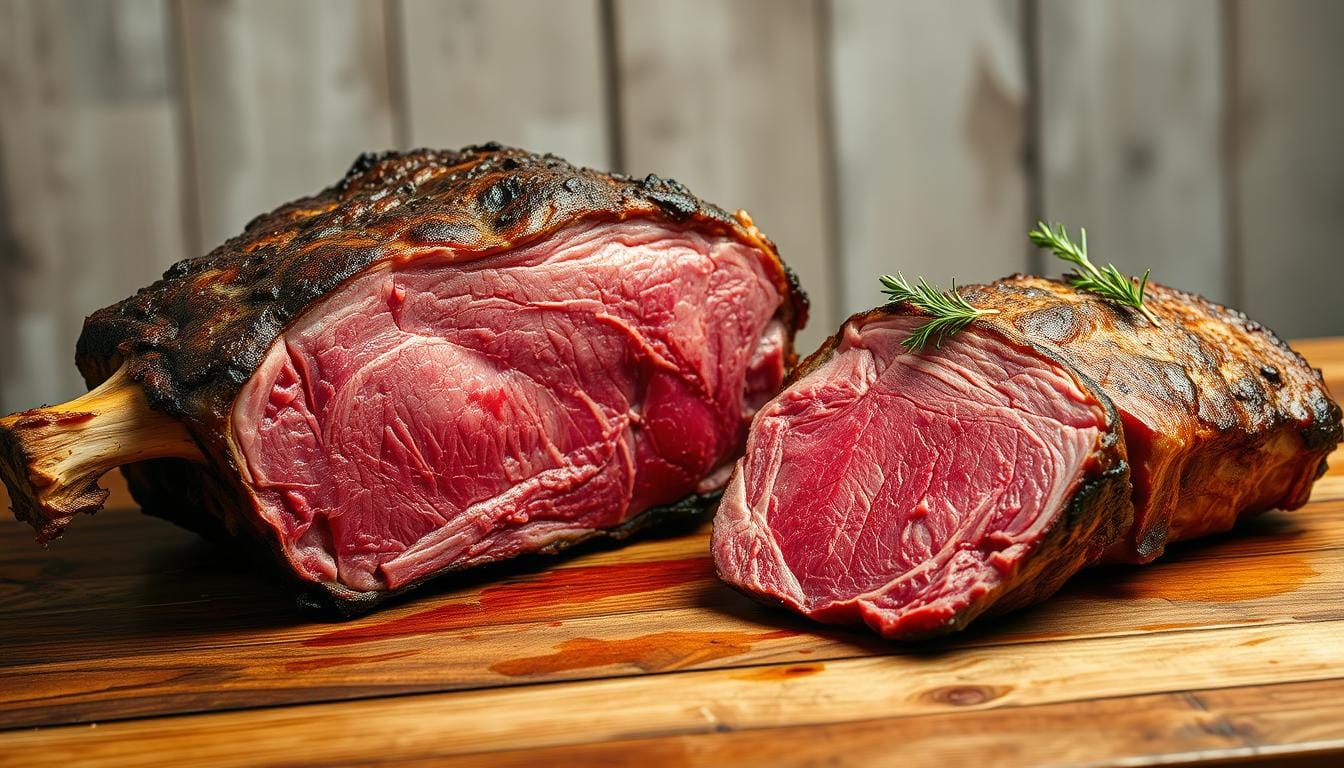Ever stood at the meat counter, confused by rib roast and prime rib? The world of premium beef cuts can be overwhelming. It’s especially tough when you want to impress your guests with the perfect roast.
Knowing the difference between rib roast and prime rib is key to improving your cooking. These cuts come from the rib primal section of the cow but are not the same. Their preparation, serving style, and flavors can greatly impact your meal.
Whether it’s for a holiday feast or just to get better at choosing beef, understanding rib roast vs prime rib is crucial. Let’s explore the tasty details that will turn you into a beef-cutting expert.
Key Takeaways
- Rib roast and prime rib originate from the same section of the cow
- Prime rib typically includes specific ribs (six through 12)
- Cooking methods differ between rib roast and prime rib
- Bone-in and boneless options affect flavor and preparation
- Understanding cut differences helps in meal planning and selection
Table of Contents
Understanding Premium Beef Cuts
Exploring premium beef cuts opens up a world of flavors and textures. The primal rib section is a treasure trove for those looking for the best prime rib.

Beef cuts are more than just meat. They are a complex culinary science. The rib section, from ribs 6 to 12, is prime for some of the most sought-after cuts.
The Primal Rib Section Explained
When comparing rib roast vs prime rib, knowing the primal rib section is key. This area, from the short loin to the chuck, holds some of the tenderest and tastiest meat.
- Contains 13 ribs on each side of the cow
- Provides both rib roast and prime rib cuts
- Known for exceptional tenderness and marbling
Quality Grades of Beef
The USDA grading system helps identify meat quality. Prime grade is the highest, with lots of marbling for rich flavor and tenderness.
“Marbling is the secret to exceptional beef flavor and texture.” – Professional Butcher
Importance of Marbling
Marbling is the fat in the meat. More marbling means more flavor and juiciness. It’s key when choosing premium beef cuts.
| Beef Grade | Marbling Level | Flavor Profile |
|---|---|---|
| Prime | Abundant | Extremely Rich |
| Choice | Moderate | Flavorful |
| Select | Slight | Less Intense |
Knowing these details helps you pick the perfect cut for your dish. Whether it’s a special occasion roast or a weeknight dinner.
What Makes a Rib Roast Special

A rib roast is a standout cut of beef. It comes from the cow’s primal rib section. This cut spans 13 ribs on each side, offering a unique culinary experience.
The size of a rib roast is impressive. It can weigh up to 25 pounds. Butchers cut these roasts into smaller pieces for cooking.
There are two main types of rib roasts:
- Bone-in cuts
- Boneless preparations
Exploring rib roast cooking methods shows its versatility. The fat content is key to its flavor. A fat cap and marbling make each slice tender and rich.
“The beauty of a rib roast lies in its ability to transform from a massive cut into an elegant, flavorful meal.” – Professional Chef
Learning about rib roast cooking methods can improve your cooking. Whether you choose bone-in or boneless, it promises a delicious meal that will wow meat lovers.
| Rib Roast Characteristics | Details |
|---|---|
| Total Ribs | 13 ribs per side of cow |
| Maximum Weight | Up to 25 pounds |
| Cut Options | Bone-in or boneless |
Defining Prime Rib: More Than Just a Name
Exploring the best cut for prime rib opens a world of beef beyond names. Prime rib is a top-notch cut that excites meat lovers everywhere.
The term “prime” often confuses many. But, prime rib isn’t always graded as USDA Prime. It’s a special cut from the cow’s rib section, ribs six through twelve.
The Origin of the Name
Understanding the difference between rib roast and prime rib starts with location. This luxurious cut is known for its tenderness and rich marbling. It’s a favorite at special meals and fancy restaurants.
Location on the Cow
- Extracted from ribs 6-12
- Part of the cow’s primal rib section
- Located in the upper rib cage area
Typical Weight and Size
A full prime rib roast can weigh up to 16 pounds. It usually gives about 12 servings. The size and weight can vary based on the butcher and cut.
“Prime rib is less about the grade and more about the specific cut of beef that promises exceptional flavor and tenderness.”
Rib Roast vs Prime Rib: Key Differences
Knowing the differences between rib roast and prime rib can make your cooking better. Both come from the same part of the cow, but they have special traits that make them different.
The main differences between rib roast and prime rib are in a few areas:
- Bone Preparation: Prime rib is usually bone-in, while rib roast can be either boneless or bone-in
- Cooking Techniques: Prime rib needs slower, more careful cooking methods
- Serving Size: Prime rib usually feeds 2-4 people per rib, while rib roast portions vary
“Not all standing rib roasts are prime rib roasts, but all prime rib roasts are standing rib roasts.”
When looking at rib roast vs prime rib, think about their special qualities. Prime rib comes from ribs 6 to 12, making up about 10% of the cow’s weight. Only 2% of beef gets the top USDA Prime grade, making it a luxury choice.
| Characteristic | Rib Roast | Prime Rib |
|---|---|---|
| Average Weight | 4-8 pounds | Up to 30 pounds (full roast) |
| Typical Cooking Time | 15-20 minutes per pound | 20-25 minutes per pound |
| Average Price | $8-$12 per pound | $15-$20 per pound |
When choosing between rib roast and prime rib, think about your cooking goals, budget, and the event. Your choice will affect the taste, look, and overall dining experience.
Bone-In vs Boneless Preparations
Choosing between bone-in and boneless cuts for a prime rib or rib roast changes your cooking methods. Knowing the differences helps you pick the best for your meal.
Deciding between bone-in and boneless affects flavor, cooking time, and meat quality. Each choice brings special qualities to your meal.
Impact on Flavor and Cooking
Bone-in prime rib is great for home cooks. The bone acts as a roasting rack, adding flavor and even heat.
- Bone-in roasts create more intense meat flavor
- Natural insulation helps maintain moisture
- Provides built-in cooking support
Which Option to Choose
When cooking prime rib at home, think about these tips:
| Number of People | Recommended Roast Size | Bones |
|---|---|---|
| 3-4 people | 4 pounds | 2 bones |
| 4-5 people | 5 pounds | 2-3 bones |
| 8-10 people | 10 pounds | 5 bones |
Boneless cuts cook faster and are easier to slice. Bone-in roasts have more flavor. Your cooking skill and taste preferences decide.
“The bone is nature’s own flavor enhancer and cooking tool.” – Professional Chef
Whichever you pick, remember to control temperature and let it rest. This ensures a perfect prime rib or rib roast at home.
Price Comparison and Value Considerations
When deciding between rib roast and prime rib, knowing the prices is key. These high-quality beef cuts have different prices due to several factors.
Here are some key price differences to consider:
- USDA Prime beef costs more because of its better marbling
- Choice grade cuts are more affordable
- Bone-in cuts usually cost more than boneless ones
The price per pound can change based on a few things:
| Beef Cut | Average Price Per Pound | Quality Grade |
|---|---|---|
| USDA Prime Rib Roast | $25-$35 | Highest Marbling |
| USDA Choice Rib Roast | $15-$25 | Good Marbling |
Your choice depends on your budget and what you plan to do with it. Prime cuts are pricier but offer amazing tenderness and taste. For cooking at home, a USDA Choice rib roast is a great value.
“The best value isn’t always the cheapest option, but the one that delivers the most satisfaction for your investment.”
Pro tip: Keep an eye out for sales during holidays like Christmas and Thanksgiving. Butchers often lower prices on premium beef during these times.
Cooking Methods and Techniques
Mastering rib roast cooking methods needs precision and understanding. Whether it’s for a special occasion or just at home, these techniques will help you make a meal like a restaurant.
Temperature Guidelines for Perfect Doneness
Getting the right internal temperature is key for a perfectly cooked prime rib. Here’s a guide to help you get the ideal doneness:
| Doneness Level | Internal Temperature | Recommended Remove Temperature |
|---|---|---|
| Rare | 120-125°F | 115°F |
| Medium-Rare | 130-135°F | 125°F |
| Medium | 140-145°F | 135°F |
| Medium-Well | 150-155°F | 145°F |
Recommended Cooking Methods
- Oven Roasting: Preheat to 325°F for consistent cooking
- Smoker Method: Set temperature at 275°F
- Searing Technique: Use 400°F surface temperature
“The secret to a perfect prime rib is patience and precision in temperature control.” – Professional Chef
Resting and Serving Tips
After cooking your prime rib roast, follow these essential tips:
- Rest the meat for 15-20 minutes
- Slice against the grain for maximum tenderness
- Use a digital meat thermometer for accuracy
- Allow 5-10°F temperature rise during resting
Pro tip for how to cook prime rib at home: Always let the meat come to room temperature before cooking. Use a 2:1 salt to pepper ratio for seasoning.
Seasoning and Flavor Profiles
Creating the perfect prime rib roast recipe begins with enhancing its natural flavors. Seasoning turns an ordinary roast into a masterpiece. Learning to cook prime rib at home shows that simple ingredients can lead to amazing results.
The key to an outstanding prime rib roast is using classic seasonings. These seasonings bring out the meat’s rich flavor. Here are some essential seasoning methods:
- Classic herb blend with rosemary, thyme, and garlic
- Coarse sea salt and cracked black pepper
- Compound butter with fresh herbs
- Smoky spice rubs for added depth
“The secret to an incredible prime rib is letting the meat’s natural flavor shine through while enhancing it with carefully chosen seasonings.”
Your seasoning technique is crucial for the prime rib roast recipe. Experts suggest coating the entire roast with seasonings at least an hour before cooking. This allows the flavors to deeply penetrate the meat.
| Seasoning Type | Flavor Profile | Best Used With |
|---|---|---|
| Herb Rub | Fresh and Aromatic | Traditional Roasting |
| Smoky Spice Blend | Bold and Intense | Grilling or Smoking |
| Garlic and Rosemary | Classic and Robust | Oven Roasting |
For those learning to cook prime rib at home, remember that less is often more. A simple mix of kosher salt, fresh ground pepper, and high-quality olive oil can make a sublime crust. This crust helps keep the meat’s juices inside.
Choosing the Right Cut for Different Occasions
Choosing the perfect beef cut can make your meal special. Knowing the difference between rib roast and prime rib helps pick the best for any event.
The right cut for prime rib depends on the event and how many people you’re hosting. Each occasion has its own needs for presentation and serving sizes.
Holiday Celebrations
Prime rib is perfect for holidays. Its big size and stunning look make it a hit at Christmas or Thanksgiving. A full prime rib is great for big groups because it:
- Makes a beautiful centerpiece for meals
- Offers big portions for family
- Looks impressive
Family Gatherings
For smaller family dinners, think about these points when deciding between rib roast and prime rib:
- How many guests: Prime rib is best for 6-8 people
- Rib roast is better for 4-6 guests
- Consider your budget
“The right cut can elevate any meal from ordinary to extraordinary.”
Remember, plan for about 1 pound of meat per two guests. This way, everyone gets a good-sized portion without too much leftover.
Common Cooking Mistakes to Avoid
Mastering rib roast cooking methods requires careful attention to detail. Many home cooks make critical errors that can ruin a perfect prime rib. Knowing how to cook prime rib at home means avoiding common mistakes.
“Cooking is about passion, and mistakes are part of the learning process.” – Unknown Chef
Here are the most frequent mistakes to watch out for when preparing your rib roast:
- Skipping the room temperature rest before cooking
- Overcooking the meat
- Neglecting proper resting time after cooking
- Using incorrect seasoning techniques
- Cutting the meat immediately after roasting
Temperature management is crucial when cooking prime rib. Let your roast sit at room temperature for about an hour before cooking. This ensures even heat distribution and prevents uneven cooking.
| Mistake | Consequence | Solution |
|---|---|---|
| Not bringing meat to room temperature | Uneven cooking | Rest meat for 1 hour before cooking |
| Overcooking | Dry, tough meat | Use meat thermometer, aim for 135-140°F |
| Cutting immediately | Loss of juices | Let meat rest 15-20 minutes before carving |
When using rib roast cooking methods, remember that patience is key. Slow roasting at lower temperatures helps maintain moisture and tenderness. Always use a meat thermometer to check internal temperature and prevent overcooking.
Proper seasoning and resting are essential steps in how to cook prime rib at home successfully. Dry brining with kosher salt for 24 hours can significantly enhance flavor and texture, making your roast restaurant-quality.
Storage and Preparation Tips
When you’re ready to cook prime rib at home, it’s important to store and thaw it right. This ensures the meat stays good and safe to eat. Your cooking methods start long before you even begin cooking.
Refrigeration and Freezing Guidelines
Storing your prime rib correctly can really affect its taste and feel. Fresh prime rib should go in the fridge and be eaten within 3-5 days. If you need to keep it longer, freezing is a great choice.
- Refrigerator storage: Keep prime rib in the coldest part of your fridge
- Freezer storage: Properly wrapped meat can last up to 3 months
- Always use airtight, freezer-safe packaging to prevent freezer burn
Thawing Techniques
Thawing safely is key to keeping the meat quality up. Learn the best thawing methods for your prime to keep its flavor and texture.
- Refrigerator thawing: Allow 24 hours of thawing per 4-5 pounds of meat
- Cold water thawing: Submerge sealed meat in cold water, changing water every 30 minutes
- Never thaw at room temperature to prevent bacterial growth
“Patience in thawing is the secret to a perfectly cooked prime rib” – Professional Chef
Pre-Cooking Preparation
Before cooking, take your prime rib out of the fridge 1-2 hours early. Pat it dry with paper towels and let it get to room temperature. This helps with even cooking in your rib roast methods.
FAQ
What is the main difference between rib roast and prime rib?
Is prime rib always USDA Prime grade?
Can I cook rib roast and prime rib using the same methods?
How much prime rib or rib roast should I buy per person?
What’s the best way to season a rib roast or prime rib?
How do I know when my rib roast is cooked to the right temperature?
Is bone-in or boneless better for rib roast and prime rib?
How long should I let my rib roast rest after cooking?
Conclusion
Learning the difference between rib roast and prime rib can change how you cook. Beef cuts offer a wide range of options, making it easy to find the right one for any meal. Whether it’s a big event or a cozy family dinner, knowing the differences helps you make better choices.
Choosing between rib roast and prime rib depends on several things. These include your budget, how you plan to cook it, and what you like to eat. Both cuts are known for their great taste and soft texture when cooked right. The most important thing is to pick high-quality meat from a trusted butcher who knows their stuff.
The difference between rib roast and prime rib is more than just words. Cows have 13 ribs on each side, offering many choices for tasty meals. By understanding these cuts, you’ll feel more confident in picking meat and cooking it, making every meal special.
Start your culinary journey by exploring these top-notch beef cuts. Try different cooking ways, spices, and recipes to find your favorite roast. Your new skills will make your kitchen meals as good as any restaurant, impressing everyone who tries them.

